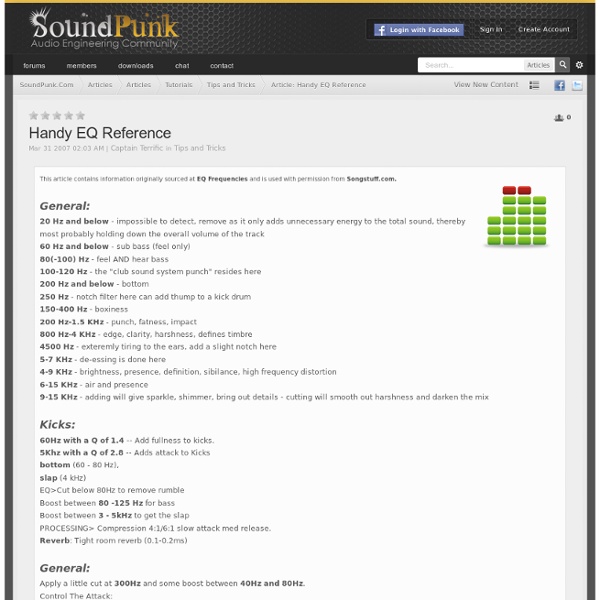



EQ Drums One of the things I love most about recording music is that there are no rules. One guy decides to use a cardboard box as his kick drum sound…and it sounds awesome. Another guy decides to sample in the sound of a screaming cat and blend it with the cymbals. (Okay, I’ve never seen that, but I bet it’s awesome.) You’re free to do whatever you want. Maybe that’s why so many people record music as a hobby. But there is one “rule” I almost always follow when mixing drums…and it almost always works. It’s really simple. I’ve heard it over and over again from mix engineers. It’s hard to explain. This is all without boosting the lows or the highs. You’ve got a set budget for the month. You’ve got a set number of frequencies to work with. You decide you want to spend an extra $200 on a piece of gear. You decide you need more low end in your kick drum. You take $200 out of ANOTHER part of the budget to pay for the gear. You cut 400 Hz to bring out the low end down at 80 Hz. What do you think?
Sound Systems | Student Technical Theatre Handbook Introduction A bare-bones sound system consists of only a few main parts. You have a bunch of sound sources (microphones, CD players, etc.) fed into a mixing board (a device which combines a bunch of inputs into a couple of outputs). Speakers Speakers are the last part of the sound system chain, and have a huge effect on the sound quality the audience hears. The first thing you need to consider when buying speakers is what frequencies you want the audience to hear. Alternately, you'll sometimes want some real low frequency rumbles. The Amplifier The amplifier takes the sound you put into it, and makes it powerful enough to drive the speakers. The Mixing Board The mixing board lets you take a bunch of sound sources and combine them into a smaller number of outputs. Sound Sources Microphones For stage, there are 4 main types of microphones you'll use: Border microphones are used at the edge of the stage/playing area to pick up the general sound. Playing recorded music Finding Sound
How Can I Set Up a Home Recording Studio on the Cheap? EQ and the Limits of Audio by TweakHeadz Lab EveryPerson's Guide to The Limits of Audio Newbie Class by Tweak The Cambridge EQ for the UAD collection. In these wonderful days of audio plugins and supercharged processors,it is tempting to ignore something as simple as EQ, short for "equalization". "But Wait!" The Tweak glares at Newb as he puts on his latex gloves, snapping them loudly. "Class, should I do it?" "No Tweak you might kill him!" Tweak drops the hammer, sends Newb to his seat and resumes his tweakly demeanor. Basic EQ Theory To understand EQ is to understand limits. Like it or not, this is all you have to work with as you put your song together. As you see there is low frequency energy extending way below what we can hear. With Waves Linear phase Bass EQ we'll apply a rather steep resonant rolloff where the bass will peak where I want it around 70 Hz and then get out of the way quick. As you see the result is dramatically conveyed in the screen. There is only one problem. Mr. The Theory of Masking "I said, get OUT!" 1. 2. 3.
10 hallmarks of amateur recordings - Hometracked We’ve all experienced it: 3 seconds into a track you’ve never heard, you know instinctively that it was recorded and mixed in someone’s bedroom. Amateur recordings often sound “amateur.” But what differentiates these hometracked opuses from professional recordings? It’s not just fidelity or sonic quality: Many competent engineers produce lo-fi or distorted mixes on purpose, when it suits the song. Rather, amateur recordings tend to share some key traits, telltale signs that the mixing and recording are the work of a novice. You can learn to recognize and address these traits in your own recordings, and produce more polished, professional mixes: Too much bass: Nothing says amateur mix like a boomy, overpowering bottom-end. See Also: 5 Ways To Improve Your Recordings Today, Record Better Vocals
untitled Producer and songwriter Fraser T Smith has made the unlikely journey from prog rock to grime. With Tinchy Stryder, his broad experience has paid off in the shape of three massive hit singles. Paul Tingen Fraser T Smith in his London studio. With American artists still dominating the hip‑hop/R&B genre, it's gratifying to see artists from different nationalities beating them at their own game. East Londoner Tinchy Stryder is one case in point. A central role in the making of the album was played by Fraser T Smith, who co‑wrote, arranged, played, mixed and produced many of the songs, including the three above‑mentioned hits. The now 38‑year‑old Fraser T Smith recalls how he took the long and winding road from old‑hippy prog rock to trendy urban youth music. Philosophy Of Everything Smith's MyAudioTonic Studio is based around Pro Tools, but with a 32‑channel Chandler summing mixer and a healthy selection of outboard. "But my setup here at the moment really works for me. 'Number One' The End